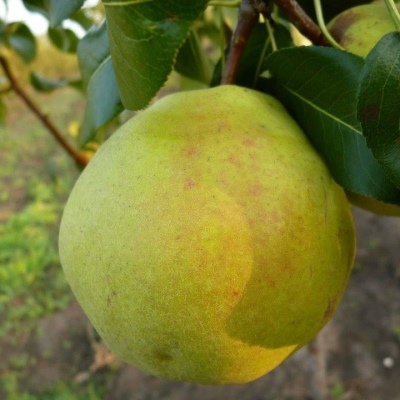
- Authors: R. D. Babina, A. F. Mileshko, V. A. Yakimov (Federal State Budgetary Institution of the Order of the Red Banner of Labor Nikitsky Botanical Garden - National Scientific Center of the Russian Academy of Sciences)
- Appeared when crossing: obtained from seeds from free pollination in 1960 of the Pass Krassan variety
- Year of approval: 2014
- Fruit weight, g: 240
- Ripening terms: late winter
- Fruit picking time: in October
- Appointment: dessert, fresh
- Growth type: medium height
- Yield: high
- Transportability: high
The Emerald pear variety was bred by Ukrainian breeders R. D. Babina, A. F. Mileshko, V. A. Yakimov in 2014. Since then, this variety has become widespread, since it combines excellent taste, large-fruited, unpretentious care. But in order to get a really good harvest, you need to take proper care of the tree.
Description of the variety
Pear Emerald belongs to the category of winter varieties. The variety has become widespread in the southern regions with a mild climate. But it is successfully grown in other regions.
The trees reach a height of 5-6 meters, they are considered medium-sized. The crown has a round shape, the leaf density is average. Leaves are oval in shape with a smooth surface.
Fruit characteristics
The fruits are quite large-fruited. Weight on average starts from 240 g, but can reach 400 g. The shape of the fruit is defined as barrel-shaped. Skin color is greenish-yellow, with purple spots in places. Often they appear precisely in places where sunlight hits. The pulp is creamy.
Taste qualities
The pulp of pears is quite dense in consistency and juicy. The taste is sweet and sour, with a tangible spice. After eating a pear, a sweet aftertaste remains in the mouth.
Pears can be eaten both fresh and used for cooking. These can be compotes, jams and other desserts. Pears of this variety are great for adding to baked goods as a filling.
Ripening and fruiting
A distinctive feature of these pears is the annual fruiting. The first pears can be tried as early as 3-4 years after planting a tree on the site. It should be borne in mind that initially the number of fruits may be insignificant. But then, as it develops, the harvest will start to increase every year (provided that the crop is well cared for).
Harvesting usually begins in late September or early October. At the same time, fruits can be stored in the refrigerator until May next year.

Yield
The pear yield is average, namely: 112 kg / ha. But in certain years, the harvest may decrease or increase depending on the influence of external factors, for example, weather conditions.
Landing
Emerald belongs to the thermophilic varieties. That is why the tree grows and bears fruit best of all in the southern regions, as well as in the North Caucasus. Growing in other regions is also possible, but in this case the weight of the fruit, their quantity and taste may vary.
When choosing a place for growing pears of this variety, it is recommended to give preference to those areas that are more protected from the wind,and they are also exposed to the sun's rays throughout the day.


Growing and care
After transplanting the tree to the chosen place, it must be watered at the root. Watering should be reduced or increased depending on specific weather conditions.
The branches of the tree need to be pruned periodically. This is necessary for the formation of the crown. If the harvest is too large, special wooden supports should be made under the branches. Otherwise, the branches of the tree can simply break under the weight of the fruit.
The trees of this variety have a tendency to self-pollinate. The pollinating varieties are: Bere-Bosk, Maria, Yakimovskaya and some others.



Disease and pest resistance
A distinctive feature of this pear variety is the high immunity to scab. But with improper care, the tree can be affected by such ailments as root rot and soot fungus. Of the insects, pear trees are most often attacked by aphids.

Like any other fruit trees, the pear needs protection from various diseases and pests. When planting a pear on your site, you need to know in advance what diseases you should beware of. To successfully carry out the struggle, it is necessary first to correctly identify the cause of the problem. It is important to distinguish signs of disease from manifestations of the presence of insects, mites, caterpillars and other types of pests.
Review overview
Gardeners from different climatic zones generally respond positively to the Emerald pear variety. They note unpretentiousness in care, taste and shelf life of fruits as the main positive aspects. Of the shortcomings, vigorous growth is distinguished.





































































